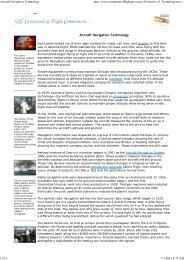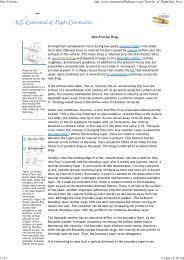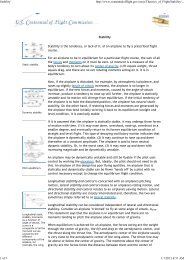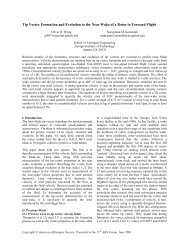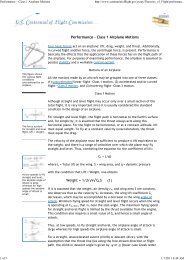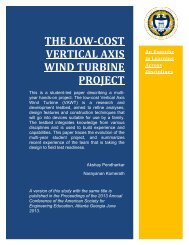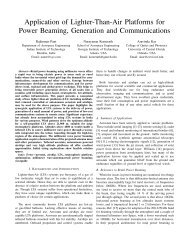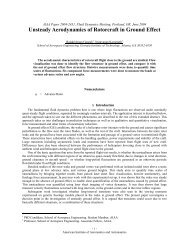Boeing-University Relations - A Review and Prospects for the Future
Boeing-University Relations - A Review and Prospects for the Future
Boeing-University Relations - A Review and Prospects for the Future
Create successful ePaper yourself
Turn your PDF publications into a flip-book with our unique Google optimized e-Paper software.
Enhancing Engineering Education – From Conception to LegacyFor many years, undergraduate engineering education has been based on <strong>the</strong> implicit assumptionthat we must attempt to teach students “everything <strong>the</strong>y might need to know” be<strong>for</strong>e <strong>the</strong>y enterprofessional practice – while trying hard not to lose too many of <strong>the</strong>m in <strong>the</strong> process 3 . As newtechnological areas became important in an engineering discipline, new courses would be addedto cover <strong>the</strong>m. While this has caused constant rethinking of what constituted “essentialfundamentals”, it has also resulted in curriculum compression – sometimes to extreme levels.Faced with pressure to add material, reduce time, <strong>and</strong> satisfy <strong>the</strong> dem<strong>and</strong>s of <strong>the</strong> (sometimesarchaic) industry hiring practices, academe too often resorted to a balkanization approach incurriculum development.One possible solution to our overall dilemma is to make <strong>the</strong> entry level requirement <strong>for</strong>professional practice a 5- or 6-year program. This is at best only a partial solution to <strong>the</strong>problem. While science <strong>and</strong> ma<strong>the</strong>matics provide <strong>the</strong> engineer much of <strong>the</strong> basic tool <strong>and</strong>knowledge suite needed <strong>for</strong> practice, it is design, <strong>and</strong> more recently its abstraction into systemsengineering, that is <strong>the</strong> essence of our profession. In educating engineers <strong>for</strong> our future, we needto think in terms of a truly student-centered approach with quality ra<strong>the</strong>r than quantity being anobjective at <strong>the</strong> undergraduate level, with much of <strong>the</strong> specialization in current programsdeferred to <strong>the</strong> graduate level <strong>and</strong> continued career-long learning opportunities.At <strong>the</strong> undergraduate level, we need to adopt a modern systems engineering perspective <strong>and</strong> do amuch better job of determining what really needs to be presented (<strong>and</strong> how to present it) in ouref<strong>for</strong>ts to educate students to operate in a modern engineering environment, ra<strong>the</strong>r than merelythinking about what specific skills <strong>the</strong>y may need in order to gain <strong>the</strong>ir initial job assignments, oras preparation <strong>for</strong> a graduate program in research. Instead of creating courses to meet specific(<strong>and</strong> too often parochial) needs, we must develop in our students a basic underst<strong>and</strong>ing of <strong>the</strong>unity of <strong>the</strong> fundamental tools <strong>and</strong> concepts needed <strong>for</strong> engineering practice ra<strong>the</strong>r thanproviding <strong>the</strong>m a vast bag of tricks <strong>for</strong> solving selected problems.Perhaps most difficult of all is to create a culture <strong>and</strong> climate where faculty are willing <strong>and</strong> ableto function as a team. In doing so, <strong>the</strong>y serve as powerful role models <strong>for</strong> <strong>the</strong>ir students - as agroup of engineers who are true exemplars of life-long learning <strong>and</strong> team-based problem solving.<strong>Boeing</strong>’s Ef<strong>for</strong>ts to Be ProactiveHaving identified <strong>and</strong> spotlighted <strong>the</strong> issues, circa 1993-94 <strong>Boeing</strong> began ef<strong>for</strong>ts to help make adifference. The structure of what became <strong>the</strong> suite of “Education Outreach” programs <strong>and</strong> <strong>the</strong>roles of <strong>the</strong> different components are shown in Fig. 2. Developed under <strong>the</strong> auspices of what isnow <strong>the</strong> company offices-level <strong>University</strong> <strong>Relations</strong> Process Council in conjunction with a selectgroup of faculty representing a cross section of universities significant to company interests, thissuite of programs <strong>and</strong> initiatives included:• An annual series of <strong>Boeing</strong>-<strong>University</strong> Workshops held from 1994-1998, whichbrought toge<strong>the</strong>r Deans <strong>and</strong> Department Chairs from approximately sixty colleges <strong>and</strong>universities across <strong>the</strong> country to discuss relations between <strong>the</strong>ir institutions <strong>and</strong> <strong>the</strong>company, share mutual concerns, <strong>and</strong> develop ways to resolve <strong>the</strong>m in cooperative ways.Proceedings of <strong>the</strong> 2005 American Society <strong>for</strong> Engineering Education Annual Conference & ExpositionCopyright ASEE 2005, American Society <strong>for</strong> Engineering Education.



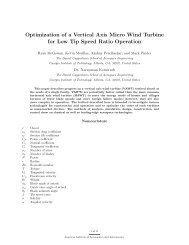
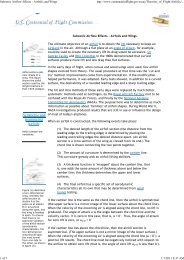

![p density of fluid, kg/m3 [Greek letter rho] V mean velocity of fluid, m ...](https://img.yumpu.com/50595898/1/184x260/p-density-of-fluid-kg-m3-greek-letter-rho-v-mean-velocity-of-fluid-m-.jpg?quality=85)
